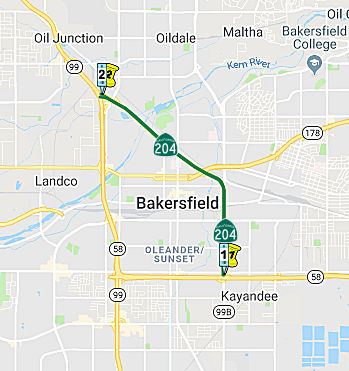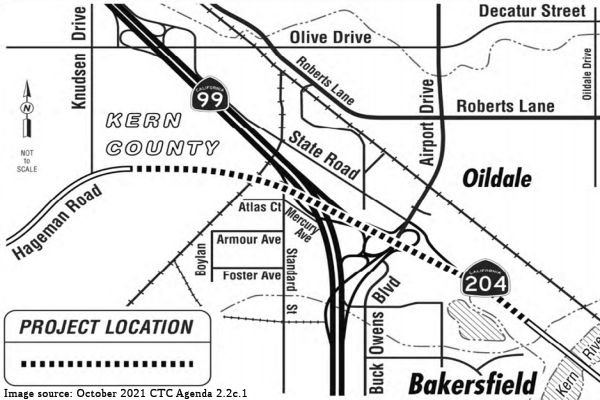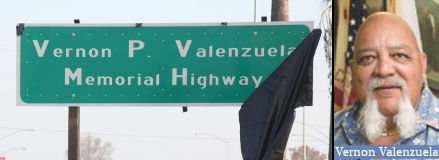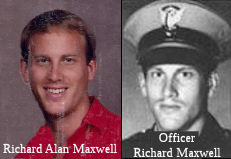

Click here for a key to the symbols used. An explanation of acronyms may be found at the bottom of the page.
 Routing
Routing From Route 58 to Route 99 near Bakersfield via Union Avenue and Golden State Avenue.
From Route 58 to Route 99 near Bakersfield via Union Avenue and Golden State Avenue.
Upon a determination by the commission that it is in the best interests of the state to do so, the commission may, upon terms and conditions approved by it, relinquish to the City of Bakersfield the portion of Route 204 that is located within the city limits of that city if the city agrees to accept it. The following conditions shall apply upon relinquishment: (1) The relinquishment shall become effective on the date following the county recorder's recordation of the relinquishment resolution containing the commission's approval of the terms and conditions of the relinquishment. (2) On and after the effective date of the relinquishment, the relinquished portion of Route 204 shall cease to be a state highway. (3) The portion of Route 204 relinquished under this subdivision shall be ineligible for future adoption under Section 81. Added by AB 1858, Chapter 315, September 18, 2006.
 Post 1964 Signage History
Post 1964 Signage HistoryIn 1963, this route was defined as "(a) Route 99 to Route 58 near Bakersfield via Brundage Lane and Oak Street. (b) Route 58 northerly to Route 99 near Beardsley School." Later in 1963, Chapter 1698 swapped a portion with Route 99, making this "Route 99 to Route 99 near Bakersfield via Brundage Lane, Union Avenue and Golden State Avenue."
In 1978, Chapter 287 changed the origin to Route 58: "Route 99
Route 58 to Route 99 near Bakersfield via Brundate Lane,
Union Avenue and Golden State Avenue."
 Pre 1964 Signage History
Pre 1964 Signage HistoryThis was part of the original routing of US 99. Before 1964, US 99 ran along Union Ave and Golden State Avenue in Bakersfield. After 1964, Route 99 was shifted westward, and the 1964 definition of Route 204 was applied to the old surface routing. Both were LRN 4, defined in 1909. Portions of this ran on the routing that was LRN 141.
By 1914, LRN 4 (future US 99, future Route 204) from Bakersfield north to
Lerdo was paved and completed to State Highway standards. By 1917, LRN 4
followed Roberts Lane and Chester Avenue over the Kern River into
Bakersfield, and continued along Chester Avenue, what appears to be 19th
Street and Union Avenue southward through Bakersfield. In 1931, a planned
realignment of US 99/LRN 4 within the City of Bakersfield was announced:
the plan was to bypass downtown Bakersfield from Union Avenue northwest
towards Beardsley Canal. This started with a new bridge over the Kern
River in 1932, moving off the Chester Ave Bridge. In 1933, the realignment
of US 99/LRN 4 was to carry the name of "Railroad Route" (approved by the
California Highway Commission on August 26th, 1932). Five railroad
crossings were eliminated by the new routing, including an overhead over
the Southern Pacific Railroad and a new Subway of the Atchison, Topeka
& Santa Fe Railroad. US 99/LRN 4 is realigned off of 19th Street
onto California Avenue between Union Avenue and Chester Avenue to make way
for reconstruction of the 1926 Union Avenue Subway. In late 1933, signage
of US 466 joined a portion of the route: from Barstow, US 466 followed LRN 58 over Tehachapi Pass into Bakersfield, reaching US 99/LRN 4 via Sumner
Street at Union Avenue as opposed to Grove Street (the LRN 58 routing).
The bypass route of US 99/LRN 4 around downtown Bakersfield via Golden
State Avenue opened to traffic as of June 2, 1934. The new alignment
of US 99/LRN 4 on Golden State Avenue split northwest from Union Avenue at
20th Street. US 99/LRN 4 on Golden State Avenue crossed through its
former alignment at Chester Avenue via the new 320' diameter Garces
Traffic Circle (completed in 1933). Chester Avenue north of Golden
State Avenue would be incorporated into LRN 142 (a former segment of Route 155). In 1935, a new Union Avenue Subway was completed on US 99/LRN 4 as a
replacement for the earlier substandard 1926 structure. The 1936-37
Division of Highways Map shows US 399 (defined in 1934) co-signed with US 99 on Golden State Avenue. US 399 is shown to multiplex US 99 from
Greenfield into downtown Bakersfield via Union Avenue where it would have
terminated at US 466. In 1957, US 99/US 466/LRN 4 on Golden State Avenue
was relocated to an overpass of the Garces Traffic Circle. Connection to
LRN 142/Chester Avenue would be made from the US 99/US 466/LRN 4 overpass
via frontage roads. The first units of the Bakersfield Bypass freeway
routing were funded in 1960-1961, and opened in 1962. US 99 moved to the
"West Bakersfield" freeway in 1963. The West Bakersfield Freeway saw the
relinquishment of Union Avenue south of Brundage Lane/LRN 141, which
truncated US 399 out of Bakersfield to US 99 at Pumpkin Center on Taft
Highway. US 466 was left as the standalone mainline route on Golden
State Avenue. The US 99 Business Route followed the former alignment
of US 99 on Union Avenue and multiplexed US 466 on Golden State
Avenue. US 399 was removed by AASHO with the great renumbering in
1964. On April 26th, 1963 the Division of Highways on behalf of the City
of Bakersfield and Kern County submitted a request to the AASHO Executive
Committee for a US 99 Business Route upon the completion of the West
Bakersfield Freeway. The US 99 Business Route as submitted was to be
signed on Houghton Road near the community of Alameda, Union Avenue and
Golden State Avenue through the City of Bakersfield.. This request
was considered by the AASHO Executive Committee on June 19th, 1963 and met
with their approval. During the 1964 State Highway Renumbering, what was
LRN 141 on Brundage Lane, Union Avenue and Golden State Avenue became
Route 204. US 466 east of Bakersfield to Barstow became Route 58,
and what was US 399 became Route 119 and an extension of Route 33. The new
Route 204 was aligned over Brundage Lane, Union Avenue and US 466/Golden
State Avenue. Former US 99 on Chester Avenue was reassigned
from LRN 142 to Route 155.
(Source: Gribblenation Blog (Tom Fearer), “California State Route 204; former US Route 99, US Route 399 and US Route 466 in Bakersfield”, April 2021)
 Status
StatusHageman Road Extension Project from Knudsen Drive to Golden State Avenue at Airport Drive (06-Ker-204, PM 5.9/6.8)
 This project proposes to extend Hageman Road in the
northwest corner of the city of Bakersfield from Knudsen Drive to Golden
State Avenue (Route 204) building a four-lane road. The total length of
the project is about 1.5 miles. The project would build a new bridge over
both the San Joaquin Valley Railroad and Route 99 and a new double-box
culvert at the Beardsley Canal lateral. The existing bridge over Airport
Drive would be widened, and existing ramps at the Airport Drive/Golden
State Avenue interchange would be modified. A new bike path crossing Route 99 would also be included in the project.
This project proposes to extend Hageman Road in the
northwest corner of the city of Bakersfield from Knudsen Drive to Golden
State Avenue (Route 204) building a four-lane road. The total length of
the project is about 1.5 miles. The project would build a new bridge over
both the San Joaquin Valley Railroad and Route 99 and a new double-box
culvert at the Beardsley Canal lateral. The existing bridge over Airport
Drive would be widened, and existing ramps at the Airport Drive/Golden
State Avenue interchange would be modified. A new bike path crossing Route 99 would also be included in the project.
(Source: Project Page, retrieved 9/2021)
In April 2017, an update was provided on the Hageman
Flyover. This project connects Hageman Road to Golden State Highway/Route 204 with roadway across Route 99 (~ 204 KER 6.596). The Design Phase is 95
percent complete; but right-of-way acquisition has not started. Caltrans
is finalizing draft plans. The city is working with San Joaquin Valley
Railroad on a construction and maintenance agreement and a California
Public Utilities Commission permit application. Right-of-way appraisals
and acquisition will not begin until design has progressed to 100 percent.
(Source: Bakersfield.Com, 4/20/2017)
In June 2021, the CTC approved amending the STIP to use
the funding available through the 2021 Mid-Cycle STIP and share
distribution of the federal Coronavirus Response and Relief Supplemental
Appropriations Act of 2021 funds (COVID Relief Funds) to add a new project
to the STIP: Hageman Road Extension to Route 204 and Flyover (PPNO 3525);
program $2,686K to the R/W capital phase in FY 2022-23.
(Source: June 2021 CTC Agenda, Agenda Item
2.1a.(19))
In October 2021, the CTC approved the following project
for future consideration of funding: 06-Ker-204, PM 5.9/6.8. Hageman
Road Extension Project from Knudsen Drive to Golden State Avenue at
Airport Drive. Construct a four-lane road from Hageman Road and
Knudsen Drive to Route 204/Golden State Avenue in Kern County.
(MND) (PPNO 3525) (STIP) (Related Item under Ref. 2.5c.(2)/2.5v.(1)). This
project is located on Hageman Road, in the city of Bakersfield, in Kern
County. The Department proposes to extend Hageman Road from Knudsen Drive
to Golden State Avenue at Airport Drive. The project will construct a
four-lane arterial road on this segment and include a structure over
Beardsley Canal and approximately a one-quarter mile of elevated
structures, spanning the San Joaquin Valley Railroad, Route 99 connector
ramp, and mainline Route 99. The existing bridge over Airport Drive will
be widened and the existing ramps at the Airport Drive/Route 204
interchange will be modified. In addition, a bicycle path will be added
along the extension. This project is currently programmed in the 2020
State Transportation Improvement Program (STIP) for a total of
$63,723,000, which includes local funds, Regional Improvement Program
funds, and Highway Bridge Program funds. Construction is estimated to
begin in 2022. The scope, as described for the preferred alternative, is
consistent with the project scope as programmed by the Commission in the
2020 STIP. A copy of the MND has been provided to Commission staff.
The project will result in less than significant impacts to the
environment after mitigation.
(Source: October 2021 CTC Agenda, Agenda Item
2.2c.(1))
In October 2021, the CTC approved an allocation of
$2,686,000 for the following locally-administered STIP project: 06-Ker-204
5.9/6.8. PPNO 06-3525; ProjID 0614000033; EA 48450. Extend
Hageman Road Easterly Across Route 99 and Connect to Route 204 In
Bakersfield. Construct the Hageman Road extension from Knudsen
Drive to Golden State Avenue at Airport Drive. The proposed project would
provide a connection between northwestern and downtown Bakersfield. The
project would extend Hageman Road from just east of the intersection with
Knudsen Drive, cross over Route 99, and connect with Golden State Avenue.
The extension of Hageman Road would be a four-lane road with two
12-foot-wide travel lanes in each direction, a 12-foot-wide median with
barrier, and 8-foot-wide outside shoulders. The Knudsen Drive intersection
would have signals. A double-box culvert structure would be built over the
Beardsley Canal lateral, with bridges over the San Joaquin Valley
Railroad, and Route 99. The existing bridge over Airport Drive would be
widened, and ramps at the Airport Drive and Golden State Avenue
interchange would be modified. The roadway section would transition to
match the existing roadway at the west and east ends of the proposed
project. Allocation: R/W $2,686,000.
(Source: October 2021 CTC Agenda, Agenda Item
2.5c.(2)/.5v.(1))
 Naming
Naming The portion of Rout 204 between Q Street and F Street in the City of Bakersfield (~ KER 4.278 to KER 5.143) is named the "Vernon P. Valenzuela Memorial Highway".
It was named in memory of Vernon P. Valenzuela, who was born in 1949. He
was raised in Bakersfield, California, the youngest of five siblings. In
1966 Mr. Valenzuela quit high school to join the United States Army and
volunteered to serve in Vietnam, serving from October 1967 to May 1968,
when he was wounded in battle. After his honorable discharge in 1969, he
returned to Bakersfield and obtained his high school diploma by attending
night school. The following September, Mr. Valenzuela became the first
member of his family to attend college. Mr. Valenzuela discovered the
large Associated Veterans Students Club at Bakersfield College, and his
association with the organization began his life as a leader and veterans
advocate. Mr. Valenzuela became an active student and held positions as
President of both the Associated Veterans Students Club and the
Bakersfield College Student Body. After graduating with an associate of
arts degree in 1973, Mr. Valenzuela continued his education at California
State University, Bakersfield (CSUB), where he was a charter member of the
first student council and began working in the Veterans Cost of
Instruction Program (VCIP). While still attending CSUB, Mr. Valenzuela was
hired to be Assistant Director of the Bakersfield College VCIP. Mr.
Valenzuela obtained his bachelor’s degree in June 1975 and began
counseling students at Bakersfield College, many of whom were veterans. He
touched so many people’s lives during his college years that for the
rest of his life he would run into people he knew while at college, who
remembered him, who were helped by him, or whose children thanked him. Mr.
Valenzuela received his masters degree in counseling in 1977 and earned
his license in marriage and family therapy in 1979, specializing in
treating post-traumatic stress disorder (PTSD). Mr. Valenzuela began his
private practice shortly after his marriage in 1981, focusing on veterans
with PTSD. He worked as a contract counselor with the Sepulveda Vet Center
from 1981 to 1989, inclusive. During the 1990s, Mr. Valenzuela traveled to
the Vietnam Veterans Memorial in Washington D.C. and joined the Vietnam
Veterans of America (VVA). He became the President of the charter chapter
of Bakersfield VVA and gradually worked through local, state, and national
levels of the organization. Mr. Valenzuela served as VVA’s
California president in 1993, and went on to serve on national committees
for PTSD, substance abuse, and the Veterans Initiative, which involved
several trips to Vietnam to recover MIA remains. Mr. Valenzuela presented
PTSD seminars throughout the nation, and was called on to work with
Oklahoma City bomb survivors and United Auto Workers members in the New
York area after September 11, 2001. During his involvement with VVA, Mr.
Valenzuela became a leading advocate for the Vet Center program, meeting
quarterly in Washington with Readjustment Counseling Services Director Dr.
Alfonso Batres to discuss issues related to the Vet Center program. In
1997, Mr. Valenzuela made a conscious decision to bring his efforts to a
more local level and was welcomed into the Kern County Network for
Children. His efforts over the last decade included advocating for
children and bridging the gap of community services for veterans.
Throughout the late 1990s, he collaborated with the network to raise funds
for graduating seniors and families in need during the holiday season
within Kern County. In April 2008, Mr. Valenzuela was recruited to be the
first Team Leader for the new Bakersfield Vet Center, helping to establish
a much needed counseling resource for combat veterans throughout Kern
County; as Team Leader of Bakersfield Vet Center, Mr. Valenzuela’s
goal was to meet all needs of the veterans, and make the vet center a safe
haven, a place where veterans could come for any help or need. He wanted
the vet center in Bakersfield to be a model for all other vet centers,
knowing that the people of Bakersfield are truly unique in their giving
capacity and collaborative efforts. In addition to providing counseling
and overseeing the operation of the vet center, Mr. Valenzuela was
instrumental in beginning the Veterans Justice Program in Kern County and,
along with other veterans and community resources, created and chaired the
newly formed Kern County Veterans Collaborative. Mr. Valenzuela’s
goal was not just to provide counseling services, but also to provide any
service or answer any question a veteran may have. Mr. Valenzuela passed
away at 63 years of age on Monday, March 26, 2012, overlooking the ocean
and surrounded by his family. Named by Senate Concurrent Resolution 4,
August 15, 2013. Resolution Chapter 69.
The portion of Rout 204 between Q Street and F Street in the City of Bakersfield (~ KER 4.278 to KER 5.143) is named the "Vernon P. Valenzuela Memorial Highway".
It was named in memory of Vernon P. Valenzuela, who was born in 1949. He
was raised in Bakersfield, California, the youngest of five siblings. In
1966 Mr. Valenzuela quit high school to join the United States Army and
volunteered to serve in Vietnam, serving from October 1967 to May 1968,
when he was wounded in battle. After his honorable discharge in 1969, he
returned to Bakersfield and obtained his high school diploma by attending
night school. The following September, Mr. Valenzuela became the first
member of his family to attend college. Mr. Valenzuela discovered the
large Associated Veterans Students Club at Bakersfield College, and his
association with the organization began his life as a leader and veterans
advocate. Mr. Valenzuela became an active student and held positions as
President of both the Associated Veterans Students Club and the
Bakersfield College Student Body. After graduating with an associate of
arts degree in 1973, Mr. Valenzuela continued his education at California
State University, Bakersfield (CSUB), where he was a charter member of the
first student council and began working in the Veterans Cost of
Instruction Program (VCIP). While still attending CSUB, Mr. Valenzuela was
hired to be Assistant Director of the Bakersfield College VCIP. Mr.
Valenzuela obtained his bachelor’s degree in June 1975 and began
counseling students at Bakersfield College, many of whom were veterans. He
touched so many people’s lives during his college years that for the
rest of his life he would run into people he knew while at college, who
remembered him, who were helped by him, or whose children thanked him. Mr.
Valenzuela received his masters degree in counseling in 1977 and earned
his license in marriage and family therapy in 1979, specializing in
treating post-traumatic stress disorder (PTSD). Mr. Valenzuela began his
private practice shortly after his marriage in 1981, focusing on veterans
with PTSD. He worked as a contract counselor with the Sepulveda Vet Center
from 1981 to 1989, inclusive. During the 1990s, Mr. Valenzuela traveled to
the Vietnam Veterans Memorial in Washington D.C. and joined the Vietnam
Veterans of America (VVA). He became the President of the charter chapter
of Bakersfield VVA and gradually worked through local, state, and national
levels of the organization. Mr. Valenzuela served as VVA’s
California president in 1993, and went on to serve on national committees
for PTSD, substance abuse, and the Veterans Initiative, which involved
several trips to Vietnam to recover MIA remains. Mr. Valenzuela presented
PTSD seminars throughout the nation, and was called on to work with
Oklahoma City bomb survivors and United Auto Workers members in the New
York area after September 11, 2001. During his involvement with VVA, Mr.
Valenzuela became a leading advocate for the Vet Center program, meeting
quarterly in Washington with Readjustment Counseling Services Director Dr.
Alfonso Batres to discuss issues related to the Vet Center program. In
1997, Mr. Valenzuela made a conscious decision to bring his efforts to a
more local level and was welcomed into the Kern County Network for
Children. His efforts over the last decade included advocating for
children and bridging the gap of community services for veterans.
Throughout the late 1990s, he collaborated with the network to raise funds
for graduating seniors and families in need during the holiday season
within Kern County. In April 2008, Mr. Valenzuela was recruited to be the
first Team Leader for the new Bakersfield Vet Center, helping to establish
a much needed counseling resource for combat veterans throughout Kern
County; as Team Leader of Bakersfield Vet Center, Mr. Valenzuela’s
goal was to meet all needs of the veterans, and make the vet center a safe
haven, a place where veterans could come for any help or need. He wanted
the vet center in Bakersfield to be a model for all other vet centers,
knowing that the people of Bakersfield are truly unique in their giving
capacity and collaborative efforts. In addition to providing counseling
and overseeing the operation of the vet center, Mr. Valenzuela was
instrumental in beginning the Veterans Justice Program in Kern County and,
along with other veterans and community resources, created and chaired the
newly formed Kern County Veterans Collaborative. Mr. Valenzuela’s
goal was not just to provide counseling services, but also to provide any
service or answer any question a veteran may have. Mr. Valenzuela passed
away at 63 years of age on Monday, March 26, 2012, overlooking the ocean
and surrounded by his family. Named by Senate Concurrent Resolution 4,
August 15, 2013. Resolution Chapter 69.
(Image source: Bakersfield Californian; Legacy.Com)
 The interchange between Rout 99, Route 204, and Airport Drive in Bakersfield (~ KER 6.431) is named the
"Richard Alan Maxwell Memorial Interchange". State Traffic Officer
Richard Alan Maxwell began his career in law enforcement with his
appointment to the California Highway Patrol on May 15, 1989, and was
killed in the line of duty on July 11, 1994. Named by Senate Concurrent
Resolution 60, Chapter 135, in 1994, and Assembly Concurrent Resolution
No. 119, Chapter 147, in 1994.
The interchange between Rout 99, Route 204, and Airport Drive in Bakersfield (~ KER 6.431) is named the
"Richard Alan Maxwell Memorial Interchange". State Traffic Officer
Richard Alan Maxwell began his career in law enforcement with his
appointment to the California Highway Patrol on May 15, 1989, and was
killed in the line of duty on July 11, 1994. Named by Senate Concurrent
Resolution 60, Chapter 135, in 1994, and Assembly Concurrent Resolution
No. 119, Chapter 147, in 1994.
(Image source: Find a Grave, Officer Down Memorial Page)
 Other WWW Links
Other WWW Links Exit Information
Exit Information Status
StatusConstructed to freeway standards from North of Bakersfield to Route 99. This is likely a business loop for Route 99. Some of the original routing near PM 6.5 has been submitted for relinquishment in December 2000.
 Statistics
StatisticsOverall statistics for Route 204:
 Pre-1964 Legislative Route
Pre-1964 Legislative RouteIn 1935, the route defined as “a new route or portion of route from Mecca to [LRN 26] via Avenue 66 and...” was added to the state highway system. In 1937, Chapter 841 repealed that definition, and added the same route ("[LRN 26] to Mecca via Avenue 66") as LRN 204. This routing remained unchanged until the 1963 renumbering.
This route runs from US 99 (present-day Route 86) to Mecca via Avenue 66. This is part of present-day Route 195, and was part of 1964-1972 Route 231.
© 1996-2020 Daniel P. Faigin.
Maintained by: Daniel P. Faigin
<webmaster@cahighways.org>.